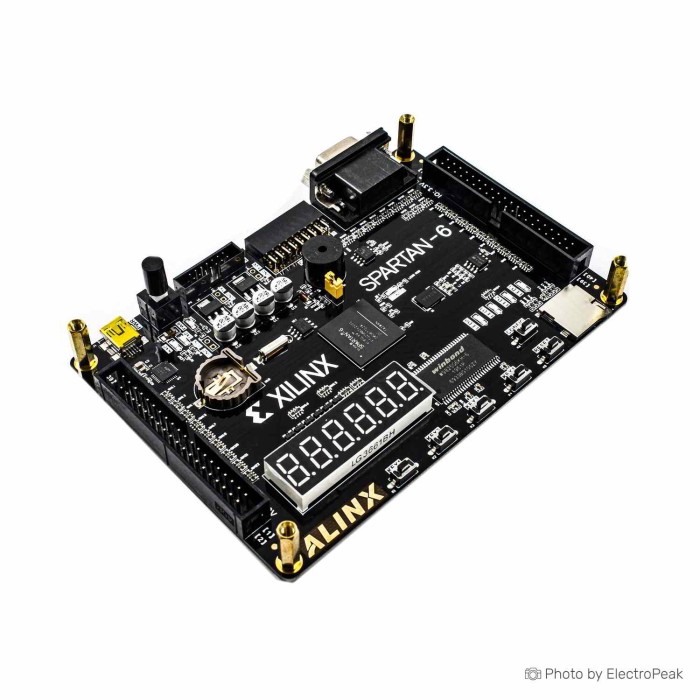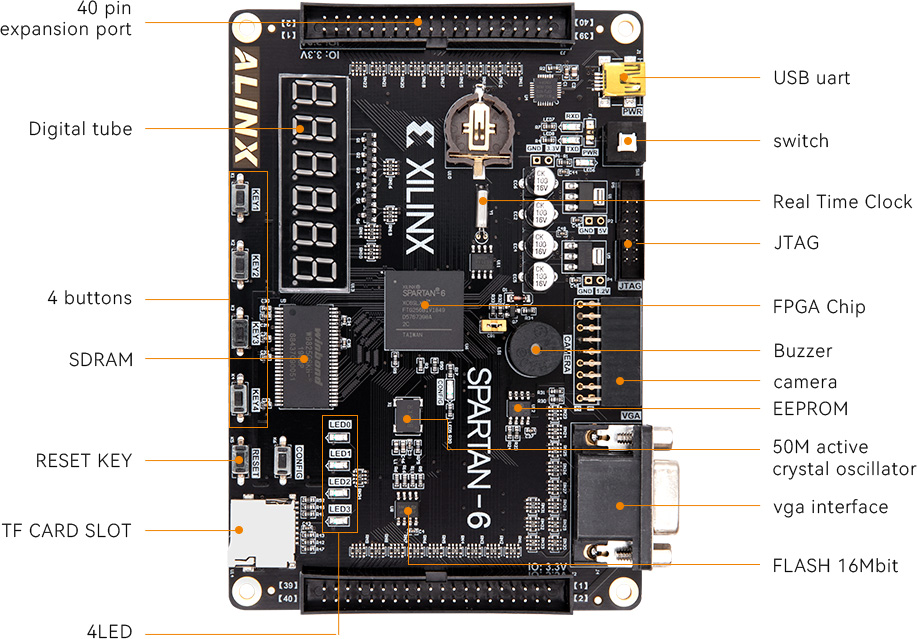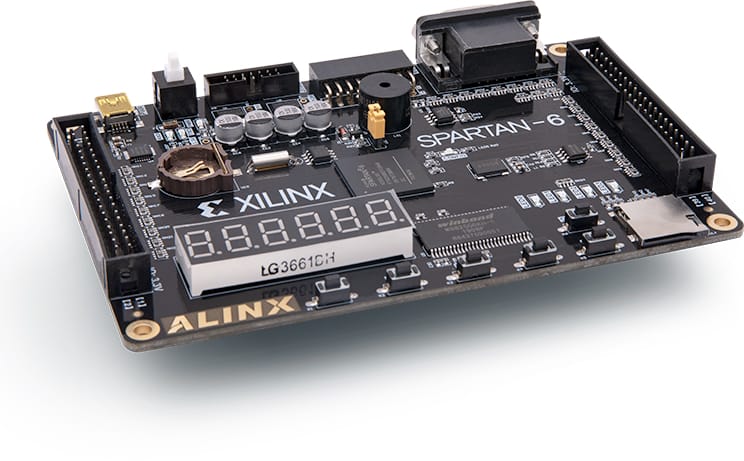The XC6SLX9 dev board is used for prototyping, development, and implementation of digital designs using Xilinx Spartan-6 FPGAs. It finds applications in areas such as digital signal processing, embedded systems, communications, and more.
Xilinx FPGA Spartan6 XC6SLX9 Development Board
Volume discounts:
- +100 1 % $82.9600
 iCESugar-nano FPGA Development Board
Previous
iCESugar-nano FPGA Development Board
Previous

The Xilinx Spartan-6 XC6SLX9 FPGA development board is a special board for people who want to learn how to work with FPGA.
This board has made it as easy as possible to learn this chip by providing most of the circuits, connectors and peripherals.
The Xilinx Spartan-6 XC6SLX9 is a Field-Programmable Gate Array (FPGA) belonging to the Spartan-6 family, which is a series of programmable logic devices developed by Xilinx. FPGAs are semiconductor devices that can be reprogrammed to implement various digital circuits and functions. The Spartan-6 family is known for offering a balance between performance, cost, and power consumption, making it suitable for a wide range of applications.
Here's a general overview of what you might find in such a development board:
Xilinx Spartan-6 XC6SLX9 FPGA chip parameters
- Model: XC6SLX9-2FTG256C
- Configurable logic block: 90Kb
- Logical unit: 9152
- Clock unit: 2
- Block RAM: 576Kb
- Core voltage: 2V
- Temperature rating: Industrial grade
- operation temperature: -40°C~85°C
Functions and interfaces of Xilinx Spartan-6 XC6SLX9 FPGA development board
- JTAG: Reserved JTAG port for FPGA debugging and program solidification
- USB interface: Power supply through USB interface, while achieving USB to serial function
- SDRAM: 1 large capacity 256Mbit SDRAM that can serve as a cache for data
- SPI FLASH: One 16Mbit SPI FLASH that can be used for storing FPGA configuration files and user data
- CAMERA: 1 camera interface, capable of connecting to 5 million OV5640 cameras
- VGA interface: 1-channel VGA interface, with a 16bit VGA interface that can display color images and other information
- Real Time Clock: 1 RTC real-time clock with battery holder, model CR1220
- EEPROM: EEPROM 24LC04 with 1 IIC interface
- LED: 4 user LEDs, capable of achieving flow light function
- Keys: 5 buttons, 1 reset button, 4 user buttons
- Crystal oscillator: A 50M active crystal oscillator on board provides a stable clock source for the development board
- 40 pin expansion port: Two 40 pin black gold standard AX expansion ports (2.54mm spacing), with 34 IO ports, including one 5V power supply, two 3.3V power supplies, and three GNDs. It can simultaneously connect two expansion modules, such as a 4.3 inch TFT module and an AD/DA module.
- SD card slot: 1 Micro SD card holder, supporting SPI mode
- Digital tube: 6-digit digital tube that can dynamically display 6-digit numbers
What you need for getting started with Xilinx FPGA Spartan6 XC6SLX9 Development Board
Programmer:
- CPLD FPGA Xilinx Platform Cable USB Programmer is an in-circuit configuratior and programmer of all Xilinx devices by PCs. This programmer is connected to PC by USB 2.0 cable, also be connected to the Xilinx devices such as FPGA, and PROM through the JTAG, Slave-Serial, and SPI communication protocol, with proper serial cable.
Development Tools:
To work with the Xilinx FPGA Spartan-6 XC6SLX9 dev board, you will need a set of development tools and software provided by Xilinx. The recommended tools for Xilinx Spartan-6 FPGAs are part of the Xilinx ISE (Integrated Software Environment) suite. However, it's important to note that Xilinx has transitioned to the Vivado Design Suite for newer FPGA families, and Spartan-6 support is available in both ISE and Vivado.
Here are the key programs you may need:
- Xilinx ISE Design Suite (ISE): The Xilinx ISE Design Suite is a comprehensive suite of tools for FPGA design, including synthesis, implementation, and verification.
- ISE includes tools like Xilinx Project Navigator, which is the main project management and design entry tool. You can download this software by clicking this link.
- Vivado Design Suite (Vivado): Although Spartan-6 FPGAs are traditionally associated with ISE, Xilinx's newer Vivado Design Suite also supports Spartan-6 devices.
Vivado is the successor to ISE and is the recommended tool for newer Xilinx FPGA families. However, for Spartan-6, you can still use either ISE or Vivado. You can learn more about this software here.
Also you can download this software by clicking this link.
You can learn this software by learning the wiki documentations of it.
FAQs
Here are some frequently asked questions (FAQs) about the Xilinx FPGA Spartan-6 XC6SLX9 development board:
What is the Xilinx FPGA Spartan-6 XC6SLX9 development board used for?
What is the difference between microcontrollers and FPGA?
Microcontrollers and Field-Programmable Gate Arrays (FPGAs) are both types of digital devices used in electronic systems, but they differ significantly in terms of architecture, functionality, and use cases. Here are the key differences between microcontrollers and FPGAs:
Architecture:
- Microcontroller: Microcontrollers are typically built around a central processing unit (CPU), which executes instructions from stored program memory (Flash or ROM).
They have fixed hardware components such as timers, analog-to-digital converters (ADCs), and communication peripherals.
- FPGA: FPGAs consist of an array of configurable logic blocks (CLBs), interconnects, and programmable input/output blocks (IOBs).
Instead of a fixed CPU, FPGAs allow you to create custom digital circuits by programming the interconnections and logic functions between configurable elements.
Programming:
- Microcontroller: Microcontrollers are programmed using high-level languages (C, C++, etc.) or assembly language.
Code is compiled and stored in non-volatile memory (Flash or ROM) on the microcontroller.
- FPGA: FPGAs are programmed using Hardware Description Languages (HDLs) such as Verilog or VHDL.
Designs are synthesized into a configuration file (bitstream) that is loaded onto the FPGA to configure its logic.
Functionality:
Microcontroller: Microcontrollers are suitable for control-oriented tasks, real-time processing, and executing pre-defined algorithms.
They are often used in embedded systems, IoT devices, and applications requiring dedicated control processing.
FPGA: FPGAs are highly flexible and can be configured to perform a wide range of parallel processing tasks.
They are suitable for applications that require high-speed data processing, custom logic, and parallel computation.
Flexibility and Reconfigurability:
- Microcontroller: Microcontrollers have fixed functionality, and changes require a change in hardware or a different microcontroller.
- FPGA:FPGAs are highly reconfigurable, allowing users to change the functionality of the device by modifying the configuration file.
Speed and Parallelism
- Microcontroller: Microcontrollers are generally optimized for sequential processing and may not perform well in parallel tasks.
- FPGA: FPGAs can exploit parallelism, making them suitable for applications that require simultaneous execution of multiple tasks.
Applications:
- Microcontroller: Microcontrollers are commonly used in applications where control and sequential processing are essential, such as in appliances, automotive systems, and small embedded devices.
- FPGA: FPGAs are used in applications requiring high-speed data processing, signal processing, image processing, cryptography, and custom hardware acceleration.
Cost:
- Microcontroller: Microcontrollers are generally cost-effective for low to moderately complex applications.
- FPGA: FPGAs can be more expensive than microcontrollers, especially for large-scale production. They are often chosen for applications where their flexibility justifies the cost.
Development Time:
- Microcontroller: Microcontroller-based development is often quicker due to the use of high-level programming languages and a more standardized development process.
- FPGA: FPGA development may take more time due to the need for hardware description languages and a more complex design process.
In summary, microcontrollers are well-suited for control-oriented tasks with fixed functionality, while FPGAs offer high flexibility and reconfigurability, making them suitable for applications requiring parallel processing and custom logic.
How do I configure the Spartan-6 FPGA on the dev board?
The FPGA can be configured using programming cables and software tools such as Xilinx Impact (for ISE) or Vivado Hardware Manager (for Vivado). You'll need to generate a bitstream file and then program it onto the FPGA.
Can I use the XC6SLX9 dev board for embedded systems development?
Yes, Spartan-6 FPGAs are suitable for embedded systems development. The dev board allows you to integrate microprocessor cores and implement custom hardware accelerators for embedded applications.
Is the XC6SLX9 dev board compatible with Linux?
Yes, both ISE and Vivado tools have versions that support Linux operating systems. You can use the tools on Linux for FPGA development with the Spartan-6 XC6SLX9.
Does the Xilinx Spartan-6 XC6SLX9 FPGA development board have an analog-to-digital converter?
Field-Programmable Gate Arrays (FPGAs) typically do not have built-in Analog-to-Digital Converters (ADCs) as a part of their core architecture. FPGAs are designed to implement digital logic and are highly configurable for a wide range of applications. They consist of configurable logic blocks (CLBs), programmable interconnects, and programmable input/output blocks (IOBs).
While FPGAs themselves do not have ADCs on the chip, they can be used in conjunction with external components, including dedicated ADCs, to interface with analog signals. Many FPGA development boards and systems include pins or connectors that allow you to connect external components, including ADCs, to the FPGA.
What programming languages can I use for FPGA development on the XC6SLX9 dev board?
FPGA development is often done using Hardware Description Languages (HDLs) such as Verilog or VHDL. These languages are used to describe the functionality and behavior of the digital circuits implemented on the FPGA.







Please complete your information below to login.
Sign In
Create New Account